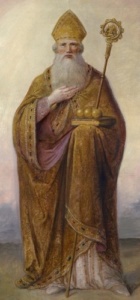 It is the common opinion that St. Nicholas was a native of Patara in Lycia, Asia Minor. He became a monk in the monastery of Holy Sion near Myra. Of this house he was made abbot by the archbishop, its founder. When the See of Myra, the capital of Lycia, fell vacant, St. Nicholas was appointed its Archbishop. It is said that he suffered for the Faith under Diocletian, and that he was present at the Council of Nice as an opponent of Arianism. His death occurred at Myra, in the year 342.
It is the common opinion that St. Nicholas was a native of Patara in Lycia, Asia Minor. He became a monk in the monastery of Holy Sion near Myra. Of this house he was made abbot by the archbishop, its founder. When the See of Myra, the capital of Lycia, fell vacant, St. Nicholas was appointed its Archbishop. It is said that he suffered for the Faith under Diocletian, and that he was present at the Council of Nice as an opponent of Arianism. His death occurred at Myra, in the year 342.
The characteristic virtue of St. Nicholas appears to have been his charity for the poor. It is also related that he was mortified and abstemious from his very infancy. St. Nicholas is regarded as the special patron of children and our well-known Santa Claus is a corruption of St. Nicholas. The Emperor Justinian built a church in his honor at Constantinople in the suburb of Blacharnæ, about the year 340. He has always been honored with great veneration in the Latin and Greek Churches. The Russian Church seems to honor him more than any other saint who lived since the days of the Apostles. His body was first laid to rest at Myra where it remained several centuries, until the year 1087, when some Italian merchants carried it to Bari, where it was placed in the church of St. Stephen.
PRAYER: O God, who adorned the holy Bishop Nicholas with countless miracles, grant, we beseech Thee, that by his merits and prayers we may be delivered from the flames of hell. Amen.
Lives of the Saints, pages 479-480